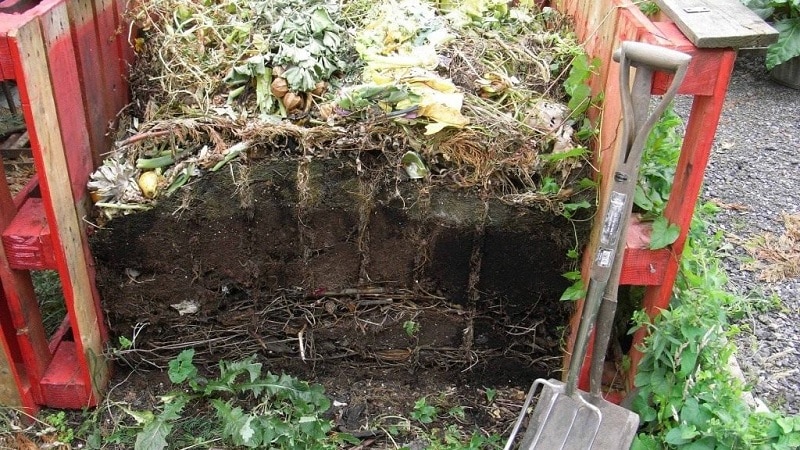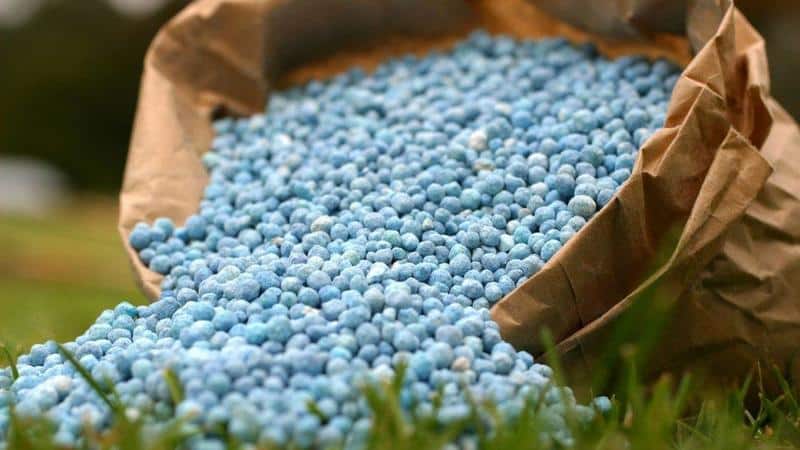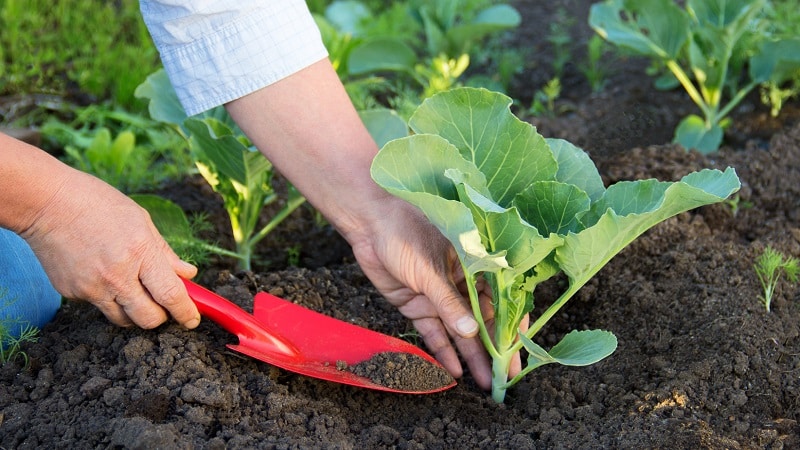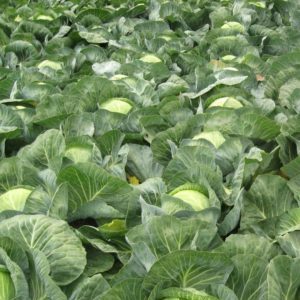What is the best way to feed cabbage after planting in the ground and in the fall?
One of the important stages of growing cabbage is fertilizing. To obtain a harvest of large and juicy vegetables, plants are provided with adequate nutrition both during the period of active growth and during the formation of heads of cabbage. Only correct and timely application of the necessary substances guarantees a good result. At the same time, the most effective fertilizers for a particular situation are selected: mineral or organic.
Types of fertilizers

Depending on the stage of development, cabbage needs different nutrients. During the first time after germination, seedlings require nitrogen for active growth.. When the leaves begin to form into heads, the role of phosphorus increases, and potassium significantly increases the crop's resistance to disease. Therefore, each fertilizer application procedure is selected taking into account the solution of specific problems.
Mineral preparations act quickly and harshly, but due to their high concentration they do not require large volumes. Organic matter acts more gently and slowly, is applied in large volumes, but also enriches the soil for a longer period.
Organic
This type of fertilizer is a waste product of plants and living organisms. Since these are natural elements of the ecological system, they are added constantly, without waiting for signs of nutrient deficiency to appear.
Organics include:
- sawdust and tree bark;
- bird droppings and manure;
- composts.

As organic matter decomposes, it releases minerals and elements that plants need for photosynthesis. Organic matter has a positive effect on the air and water nutrition of plants, creating a beneficial environment for the proliferation of beneficial microorganisms and bacteria that form a symbiosis with the root system of cabbage.
Important! In order for organic substances to work most effectively, they are made into fine powder or used only in fermented, rotted form.
Manure and bird droppings are most often used for liquid feeding. Nitrogen compounds evaporate from the fermented infusion, so the working solution is enriched with ammonium sulfate (10–20 g per 10 l).
Compost is a rotted mixture of turf and organic waste (sawdust, weeds, fallen leaves), upon receipt of which the unnecessary is disposed of and a multi-component fertilizer with a rich composition is created.
Mineral

These substances quickly and easily give a positive effect. Mineral salts contain all the elements necessary for plant growth. Depending on the stage of cabbage development, fertilizers with a simple composition or complex ones containing several components are chosen.
Types of mineral fertilizers:
- nitrogen: ammonium nitrate, urea;
- phosphorus: superphosphate, phosphate rock;
- potassium: potassium chloride, potassium sulfate, potassium magnesium;
- complex: ammophos, potassium nitrate, nitrophoska.
When choosing a fertilizer, be sure to take into account the condition of the soil and the climatic characteristics of the region.
Important! Unlike organics, when working with chemicals, they protect open areas of the body and respiratory tract from accidental contact with the working solution.
How to feed cabbage in open ground
In order for cabbage to actively increase its green mass, become hardy and produce a rich harvest, both organic and mineral fertilizers are used. Plants are fed at the root and leaf level.
After landing in the ground

The first fertilizing is done 2-3 weeks after the seedlings are planted in open soil. Then the procedure is repeated regularly, every 20 days. Fertilizers are applied 3-4 times during the season. Choose one of the suitable methods or alternate chemicals with natural substances.
First feeding
This procedure is skipped if, when planting plants, a handful of compost and a matchbox of wood ash were first added to each hole. If fertilizing is required and organic matter is chosen, a liquid concentrate is prepared in advance: manure and water are mixed in a ratio of 1:5. Mullein that has been infused for 2-3 days is diluted before use: 0.5 liters of the mixture per 10 liters of water.
How to feed cabbage after planting in the ground? Nitrogen fertilizers are chosen from mineral substances. Use urea (30 g per 10 liters of water) or ammonium nitrate (20 g per 10 liters of water). Another option for a complex working solution is 10 g of potassium chloride, 40 g of superphosphate, 25 g of ammonium nitrate per bucket of water.
Read also:
The best Dutch varieties and hybrids of white cabbage
The best varieties of cabbage for pickling and storing for the winter
Second feeding
For better growth of leaves, cabbage is fertilized comprehensively: 30 g of azofoska per 10 liters of water and 15 g of preparations with microelements in the composition (Kemira, Kristalon, Solution) or use nitrophoska (2 tbsp per 10 liters of water) .
The organic version is prepared using an ash solution: 1 tbsp. wood ash is dissolved in a bucket of water, left for 2-3 days, filtered. Add 0.5 liters of mullein and mix thoroughly.
Third feeding
In time, it coincides with the beginning of the formation of heads of cabbage. Nutrient compositions with a predominance of phosphorus are used - this allows you to obtain dense, large heads of cabbage. Complexes are prepared with organic matter and mineral salts.
To 10 liters of water add 0.5 liters of mullein or liquid chicken manure, 30 g of superphosphate, 15 g of preparations with microelements, or pour 0.5 liters of mullein into a bucket of water and add 1 tbsp. l. superphosphate and 1 tsp. potassium fertilizer.
Fourth feeding
When the leaves grow large, the cabbage is sprayed - this gives quick results. Boric acid is used as a preparation: 1 tsp. powder is stirred in 1 tbsp. hot water. The mixture is poured into a bucket of water, and the prepared solution is sprayed onto the cabbage. They use dusting with fine wood ash: sprinkle the leaves after rain or watering so that the dust ash sticks well.
Important! Dusting repels slugs if you sprinkle ash between the rows. Ash infusion is used to combat aphids and cruciferous flea beetles.
Treatment of leaves with preparations containing boron and molybdenum increases productivity. A solution is prepared from 10 liters of water, 10 g of ammonium molybdate, 10 g of boric acid. Spray 2 times: during the development period of 4-5 leaves and in the growth phase of 12–15 leaves.
Fertilizers for cabbage in autumn

This procedure is carried out no later than 20 days before the harvest day.. It is used only for late varieties of cabbage and is aimed at ensuring that the heads of cabbage do not spoil during storage and do not lose their taste.
Method using minerals: 40 g of potassium sulfate is dissolved in a bucket of water and applied to the root. Ash infusion is used as organic matter. It is prepared from a bucket of water and 1 tbsp. ash: mix everything, leave for 3 days and filter.Working solution - 0.5 liters of infusion per 10 liters of water.
How to fertilize cabbage
Proper application of fertilizers ensures that the plant absorbs all the elements.
Step-by-step feeding instructions:
- Choose a cloudy day or start the procedure in the evening.
- Water thoroughly or choose a time after rain.
- Prepare a working solution.
- Water each plant, observing the consumption rate - from 0.5 to 1 liter of solution per 1 root.
After applying fertilizers, the rows are loosened to remove weeds and prevent the formation of a dense crust on the soil. Spraying is carried out in cloudy, windless weather or at sunset, after watering.
Read also:
Early maturing cabbage hybrid Krautkaiser F1
Conclusion
Good productivity of cabbage is ensured by the beneficial substances it receives from fertilizers during the entire growing season. During the season, 3-4 feedings are carried out. They use mineral products (nitrogen, potassium, phosphorus, depending on the period of development) or organic (infusion of manure or ash, compost).
Foliar fertilizers additionally protect the crop from pests. Cabbage is fed regularly, the period between procedures is at least 20 days.